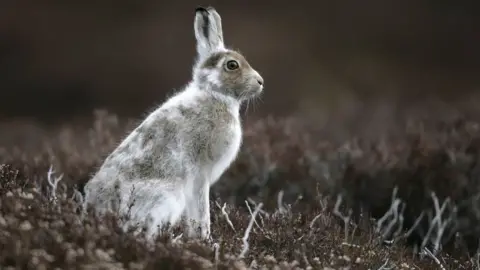'More mountain hares' on grouse shooting moors
 Getty Images
Getty ImagesMore mountain hares have been counted on moorland managed for grouse shoots than unmanaged moorland, gamekeepers and landowner groups have claimed.
They are using new methodology to assess numbers of the animals, which are the subject of annual culls.
The groups said initial results suggested there were tens of thousands of hares on areas of managed moorland.
RSPB Scotland, which criticises hare culling, said counts should be independently administrated.
Mountain hares are Britain's only native hare and may have been here since the last ice age.
Reasons for culls include reducing the risk of a tick-borne disease spreading to grouse. But conservationists blame culling for a "dramatic decline" in hare numbers.
This year gamekeepers have been trialling a new methodology developed by by Scottish Natural Heritage, James Hutton Institute and the Game and Wildlife Conservation Trust for estimating hare numbers.
It involves gamekeepers counting hares just after dusk, when the animals are said to be the most active, rather than during the day.
Estimated numbers for an estate is reached using an app developed by Imperial College London.
Estates in the Cairngorms have been among the first to introduce the new approach.
The British Association for Shooting and Conservation; the Scottish Countryside Alliance, Scottish Land and Estates; the Scottish Association for Country Sports and the Scottish Gamekeepers Association said initial results suggested there were tens of thousands of hares.
'Serious concerns'
In a joint statement, the groups said the first set of data recorded under the new system showed an average of 13.7 mountain hares encountered per kilometre at 27 surveyed sites.
They said Scotland had approximately 135,000 hares, with most of them found on grouse moors.
On managed grouse moors, mountain hare populations were "up to 35 times higher" than on unmanaged moors, they added.
Alex Hogg, chairman of the Scottish Gamekeepers' Association, said: "Keepers have been very willing to adopt this approach favoured by the scientists and conservation bodies.
"We have always recorded data on mountain hare populations but it is certainly worthwhile to use the same system across the whole of Scotland and to be able to instantly record counts and upload the data for analysis.
"It is clear that the techniques employed to manage land for grouse shooting also benefit mountain hares."
RSPB Scotland said studies published last year confirmed its "serious concerns" that mountain hares had "declined dramatically" across Scotland.
James Silvey, species and habitats officer with RSPB Scotland, said the most "severe declines" had been on land managed for driven grouse shooting.
He said: "Whilst the adoption of a consistent field method for counting hares is welcome, for any national monitoring programme to be of any value it must be administered independently, ideally by government."
